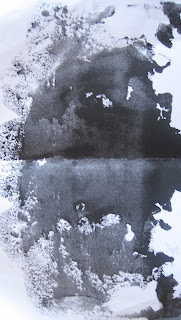For this assignment we were to look at the idea of Polysemy. Polysemy is when a word has two or more similar meanings and that everyone interprets them differently. Apparently all images are 'Polysemous' and that different text or imagery can completely change and 'fix' the meaning. In the essay 'The Rhetoric of the Image' the author Roland Barthes asks, 'How does meaning get into the image?' and this is what we were attempting to find out by carrying out this experiment.
Our group decided to go for the ink blot experiment and started by creating our random ink blots. I then went about asking my 3 non art student flatmates over a cup of tea, "what do you see?" The results were more interesting than i thought.
Ed - a business student and all round extreme sports guy thought the 1st looked like an angry dolphin, the 2nd a brain and the 3rd some skis.
Robbie - Ray Mears wannabe and Geography student thought that the 1st was a horse shoe crab, 2nd a space volcano and the 3rd some tree bark.
Nick - Film and English student and radio 4 listener saw the 1st as a spinning diablo, no 2 as rain on a window and the 3rd as smudged musical notes.
Apart from being totally different it was strange how what each person saw completely represented their interests and personality. (It probably would have been beneficial to speak to more people, perhaps within a different age range or social environment.) The next part of the experiment was to add some text or extra pieces of imagery to 'fix' the image and hopefully encourage everyone to see the same thing. To the 1st i added 2 triangles to the top to represent ears and now all three saw either a fox or cat. On the dotty example i wrote the words, 'buzz, buzz' and immediately they all saw bees. Thirdly i added blue ink to the liner example and 2 out of three now saw water. It is impressive how 3 such different views could be altered to the same by such simple additions.
It makes you think about the power of images in advertising and how they are manipulating images to make us, the consumers see their products positively and want to buy them. When i told my three experimentees the results they also commented that they couldn't believe how susceptible they had been and how much I'd influenced them into seeing what i wanted them to see.
I also told them i had sneaky ways of getting them to do the dishes, so they'd better watch out!



Ha ha, thats pretty good Amy, could you try it on my kids?
ReplyDelete